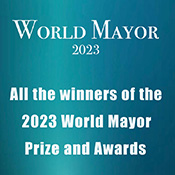
 |
Voter turnout in mayoral elections |
|
FRONT PAGE About us   ON OTHER PAGES Mayors, parties, politics Mayors COVID-19 Mayors in Europe: Politics & Powers (2019) World's capital cities and their mayors (2020) Salaries of British mayors Salaries of French mayors Salaries of German mayors Salaries of Japanese mayors African American Mayors Belgian Mayors (2020) British Mayors (2021) Canadian Mayors (2021) French Mayors (2020) German mayors (2021) Indian mayors (2020) Italian mayors (2021) Japanese mayors (2021) Polish mayors (2020) Spanish mayors (2020) Turkish mayors (2019) US mayors (2020) Women in US local government World Mayors and politics Voter turnout - an international comparison Largest cities in the world and their mayors (2017) Largest cities with women mayors (2017) Capital cities and their mayors (2017) |
 International comparison of voter International comparison of voterturnout in mayoral elections May 2018: Devolution of economic power from London to the English regions and the creation of regional/metro mayors was the flagship political initiative of Britain’s 2010-to-2015 coalition government. The first group of English regional mayors, who will have considerably political and economic clout, was elected on 4 May 2017 by a decidedly unenthusiastic electorate. Only in one region, Cambridgeshire & Peterborough, was voter turnout above 30 per cent. In Tees Valley, an area, which includes the cities of Darlington, Hartlepool and Middlesbrough, just above 21 per cent of voters bothered to take part in the election, meaning that the new Conservative mayor was elected by less than 15 per cent of the electorate. A strong mandate it is not. However, voters’ interest in municipal affairs is even lower in the US. The below figures show that mayoral elections in some the country’s largest cities attract seldom more than 30 per cent of people eligible to vote. In Dallas only six per cent of voters took part in the mayoral election. Voter participation in German mayoral elections is usually between 40 and 50 per cent, while in Italy turnout between 50 and 60 per cent is not uncommon. In Japan, the average voter turnout in the 62 mayoral elections in 2015 stood at a record low of 50.5 per cent, down from the last round of mayoral elections held in 2011, which saw an average 53 per cent turnout rate. Average turnout for city assembly elections also fell to 49 per cent, and dropped to 69 per cent for mayoral elections of towns and villages. In Tokyo’s 2016 gubernatorial election, however, turnout increased from 46 to 59 per cent. International comparison of voter turnout in mayoral elections (1) In cases of two rounds of voting, the above figures represent the turnout in the second round. (2) Data supplied by Portland State University. © Copyright: City Mayors. All rights reserved Follow @City_Mayors |